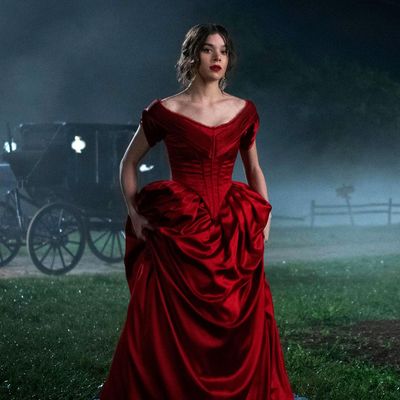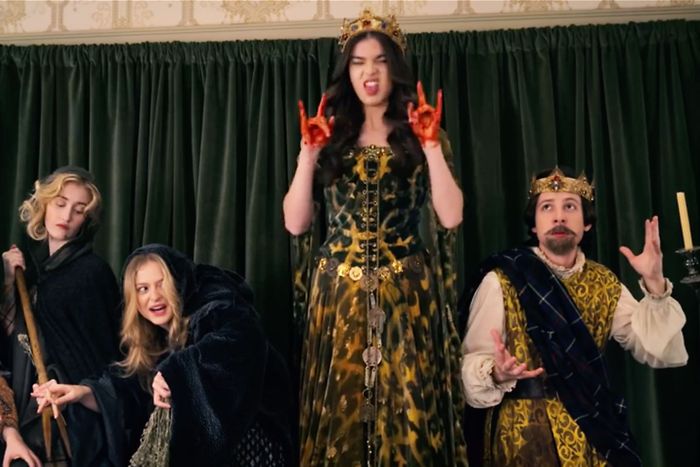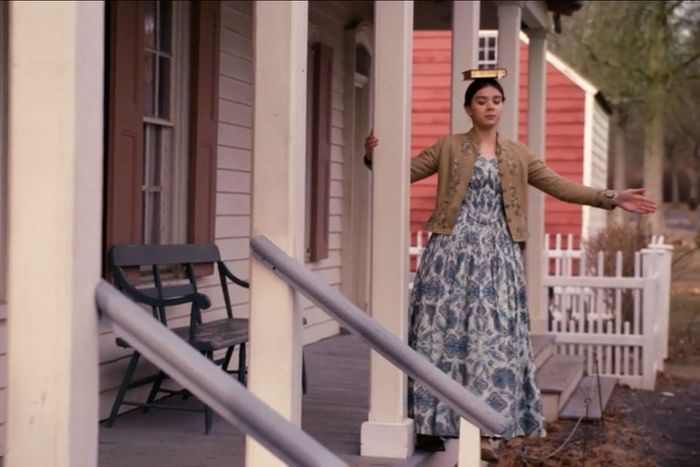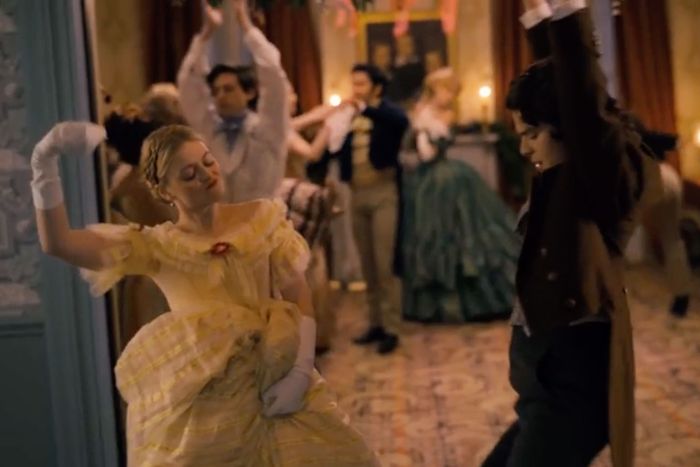
On November 1, Apple will unveil its glittering lineup of original television shows, with the prestige you might expect from an A-lister-filled drama about TV news and a show about serious men and women going to space. But there’s also an anomaly: A show about Emily Dickinson, that spinster-ish poet you read about in high school? Where she’s young and rebellious? Starring Oscar nominee and pop star Hailee Steinfeld? Is this some Riverdale knockoff? Has TV’s great horny-industrial complex claimed another victim?
The version of Emily Dickinson you see in Dickinson very much does fuck, but the show isn’t really a teen soap. Instead, it’s a bleak-as-hell 30-minute comedy about a moody poet who keeps rebelling against her parents. And it’s a queer love story about Dickinson’s relationship with her sister-in-law. And also, a gothic horror story about how she never actually did escape her own home. But creator Alena Smith doesn’t mind if you refer to the show as “Sexy Dickinson.” “Why do we think of her as this sexless shut-in?” Smith said. “I wouldn’t want to watch a show not about sexy Dickinson.”
In Dickinson’s first three episodes, Emily takes a carriage ride with Death (who happens to be played by Wiz Khalifa), cross-dresses to sneak into an all-male Amherst College lecture about volcanoes, and stages a house party where everyone takes opium and twerks. She wears impeccable period costumes, but sits like she’s lounging on a couch for a TV binge, and she talks like someone who has high-speed internet and lives on a healthy diet of memes. If Emily Dickinson were alive today, Steinfeld joked, “Her Twitter would be popping.”
This is obviously not a historically accurate depiction of Emily Dickinson’s life and times, but to Smith, it’s spiritually accurate in its way. The show draws inspiration from the enigma of Dickinson’s poetry, building off the scarce known facts about her life. “Everyone’s free to invent their own Emily Dickinson, and this is mine,” Smith said. “I don’t in any way say it’s the authoritative version.”
The goal, essentially, is to blur the 1850s and the present day, making the argument that Dickinson — whose work is sexy, irreverent, queer, and much more challenging than you might remember from high school — is best understood as a contemporary millennial. Dickinson’s historical circumstances are generally accurate, but the episodes are all set to a contemporary soundtrack that samples everything from Billie Eilish to Mitski. “The whole intention of the show is to make us lose track of the difference between the present and the past,” Smith said.
Smith, who graduated from Yale drama school in 2006 and had a career as a playwright in New York before writing on shows like The Affair and The Newsroom, first started working on the idea that became Dickinson in 2013. “I had this bizarre idea to make an experimental half-hour show about Emily Dickinson,” she said. Smith had grown up in the Hudson Valley and gotten interested in Dickinson as a writer in her early 20s, feeling a kinship with the way she felt “trapped and misunderstood the way a lot of young artists do” and becoming drawn to the poet’s “morbid wit.”
In writing the show, Smith decided that Dickinson’s life fit well into the format of “bleak, ironic” comedy: She lived with her family in 19th-century New England, never married, rarely traveled, and became increasingly reclusive in her later years. Most of her work went unpublished until after her death in 1866. As Smith saw it, the status quo that governs a sitcom is also a sort of gothic horror story to live through. No matter what happens, at the end of the day, Emily always has to return home to the same house and the same family. “On the outside, her life has maybe the structure of the British Office,” she said. “But inside, it’s a lot more than that.”
From that idea, Smith got interested in the eerie parallels between 1850s America and today, especially the sense of living within a fractured political system with a fear of an apocalyptic end, whether from war or climate change. “In the same way that we look around and feel like everything is changing so fast under our feet, they were on the brink of Civil War,” she said. “Many ideals that the country had only been recently built upon were proven to be deceptive or untenable.” On the show, Dickinson’s Whig-affiliated politician father Edward (Toby Huss) insists that he’s against slavery, but wouldn’t be so radical as to call himself an abolitionist, in a dig against the oblivious centrist politicians of today. “Maybe we still have Whigs in this country and we don’t know it,” Smith joked.
In researching the show, Smith read “every biography of Dickinson that there is,” including scholarly analyses of her poems (one Dickinson scholar, Alexandra Socarides, is a family friend), and also consulted with Civil War historians. She avoided seeing either of the two recent Dickinson movies, 2017’s A Quiet Passion and 2019’s Wild Nights With Emily, however, because they came out while she was working on the show and she “didn’t want to get screwed up by watching them.”
She also, of course, read Dickinson’s poems, which form the backbone of the show, giving a structure and a title to each episode. “It’s not that in each episode she writes a poem, but each episode uses one of her poems in order to explore a given theme,” Smith said. “She wrote so many great poems that are so evocative and imaginatively exciting that they’re sort of an inexhaustible resource.”
From 2013 on, Smith developed the project “kind of in secret,” working on a pilot script on spec, then taking it to producers Michael Sugar and Ashley Zalta at Sugar23 a few years into the process. In 2017, they brought the show to Apple, to whom they’d promised a first look, and the tech company bought it after hearing Smith’s pitch for the first three seasons. (According to the Hollywood Reporter, Dickinson is currently in production on season two, though Smith told Vulture she couldn’t discuss future seasons.) “This was a very, very thoroughly thought-out project, because it had had so much work,” Smith said. “But ultimately, it was one pitch.” She pitched the show on a Friday, and Apple bought it on Monday.
For the concept to work, Dickinson needed a great Dickinson, and Hailee Steinfeld was the first person they went to with a script. “The fact that she’s American was really important,” Smith said, “I didn’t want a Brit because I think our typical idea of period is always a Brit. And Emily Dickinson is an American poet. And there’s also something about Hailee that is just so contemporary.” Steinfeld said that she decided to sign onto the series, which she also executive produces, after in-depth conversations with Smith: “It’s empowering to play this character who would stop at nothing to do whatever made her feel creatively alive as an artist.”
The show focuses on Emily’s immediate family, including her father Edward (Toby Huss), her mother Emily Norcross Dickinson (Jane Krakowski, obsessively cleaning or cooking in nearly every scene), her brother Austin (Adrian Blake Enscoe), her sister Lavinia (Anna Baryshnikov), and her friend, love interest, and future sister-in-law Sue Gilbert (Ella Hunt). There’s a significant amount of historical evidence that Sue and Emily had a sexual and/or romantic attachment, which was also explored in last spring’s Wild Nights With Emily, and their relationship is a key part of the show. “In all my research of Dickinson, that is the core romantic relationship of her life, however you want to define it,” Smith said, pointing out that people in Dickinson’s era likely wouldn’t have thought or acted in terms of the categories we use to define sexuality today, and defined her lead character’s sexuality as “fluid or queer.” “Sue is not her only romantic interest in the show, but I think Sue is Emily’s core soulmate,” Smith said. “At least that’s what Emily was so desperate for Sue to be.”
Among Emily’s other romantic interests: The literal embodiment of death, played by Wiz Khalifa, and who appears in several episodes over the course of the season. “Emily, at least in the beginning of the show, glamorizes death,” Smith said, so she wanted to cast “the coolest guy” she could think of to play him. “Part of her coming-of-age story over the course of the season is coming into a more mature relationship with death when she actually loses someone who is important to her.”
There’s also a set of guest appearances, including John Mulaney as Henry David Thoreau (“We cancel him!” Smith said with delight) and Zosia Mamet as Louisa May Alcott. Even the minor figures on the show are also based on real people; their names were borrowed from records about the Amherst railroad. “Pretty much every single character is named at least after a real person that was alive in Amherst at the time,” Smith said.
Given that Dickinson takes place in rural Massachusetts in the 1850s, many of the historical figures that appear on it are white. Though the show takes liberties in other ways, Smith decided not to do colorblind casting because she wanted to talk about race “authentically.” This doesn’t mean that the town of Amherst on the show is entirely white, however. “A lot of our ideas about race in the 1850s we got through movies and books that were made in other times and that are more racist and more segregated than you would expect things to be,” Smith said. “If you were in a lecture room in Amherst, you wouldn’t see all white faces.” Edward Jones, the first black student to graduate from Amherst, graduated in 1826, while Joseph Hardy Neesima, class of 1870, was the first Japanese student to graduate. Though Neesima may not have known Dickinson personally, a character based on him (played by Kevin Yee) does appear on the show. “I wasn’t going to pretend that one of the Dickinsons wasn’t white because that would erase the truth,” Smith said. “But I was looking really hard for ways to find the characters who weren’t and then show them.”
To underline the association between the present and the 19th century, Dickinson’s soundtrack is full of modern needle drops — the more of-the-moment, the better. In essence, if Emily Dickinson were alive today, it feels like you’re inside her iPhone (and it would be an iPhone, considering this is an Apple show). “If you used a song from the ’80s or the ’70s, the whole thing collapsed because all of a sudden you were introducing another temporal dimension, and we want this very strict binary between now and then,” Smith said. She would write suggestions for songs into scripts, and then consult with other writers and producers to select what would end up on the show. Having the support of Apple Music helped, both in song selection and being able to license whatever they needed from Apple’s library. An executive at Apple Music sent Smith “bury a friend,” the Billie Eilish track that appears in the pilot, before the song itself came out. “I didn’t know who Billie Eilish was, and I listened to it and I was like, Holy shit, this sounds like it was written by Emily Dickinson,” she said. “That was so long ago. I don’t even know how fresh that is.”
To Smith, including a wide selection of music from different artistic backgrounds also fit with the style of Dickinson’s poetry. “Emily Dickinson appropriated in her poetry. She appropriated the rhythms of her Irish maid. She appropriated the language of the Native Americans who came by the house to sell baskets,” she said. “America has always been a melting pot. Even if you’re an uptight New Englander, you’re going to be affected by the language that’s around you.”
While Dickinson sounds heady and conceptual, the series still looks like a period drama, with meticulously recreated interior sets shot at Steiner Studios in Brooklyn and exteriors shot at “this weird 19th-century period village” at Old Bethpage Village on Long Island. At the encouragement of director David Gordon Green, who shot the pilot, the cast took etiquette and cooking classes. “They really did have us plucking real chickens and taking real innards out of things,” Jane Krakowski said.
Smith was careful to keep the characters’ language and mannerisms period-accurate — at least up until the point where they rebel and sound like internet-age meme creators — but as she admits, there’s no exact style guide to the show. “We’re looking for details that uncannily resonate with where we are today,” she said. “You could imagine someone in the 1850s having a bitch, please moment. That was probably an emotion that was available to them.”





